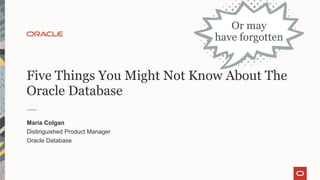The document discusses five lesser-known features of Oracle Database, including indexed management and online operations, emphasizing their importance in improving performance and optimizing resource usage. It highlights strategies for managing indexes and schema objects efficiently, such as using invisible indexes and parameterized views, to mitigate the risks associated with maintenance activities. The content also outlines best practices for handling statistics gathering in order to test changes without impacting system stability.















































